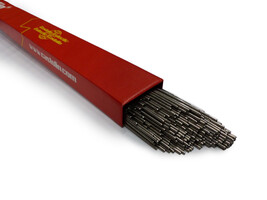Our high-quality TIG welding rods for unalloyed and low-alloy materials offer a reliable and precise solution for demanding welding applications. With state-of-the-art welding technologies and years of experience in the industry, we guarantee the highest quality and reliability. Choose non-alloy and low-alloy welding with TIG process for a powerful and effective welding solution that gives you precise and reliable welding results. With this advanced welding technology, you can be sure that your welding work will meet the highest standards.
TIG welding, also known as tungsten inert gas welding, is a type of arc welding in which a non-consumable tungsten electrode is used to create an arc between the electrode and the workpiece. A shielding gas, usually argon or helium, is used to protect the welding area from oxidation. TIG welding is a versatile process that can be used to weld a wide range of materials, including unalloyed and low-alloy steels.
TIG welding rods are used to add a filler metal to the weld. The type of TIG welding wire used depends on the material to be welded. For unalloyed and low-alloy steels, a TIG welding wire made of a similar material is generally used. A TIG welding wire made of unalloyed steel would be used for welding structural steel, for example.
TIG welding rods are available in various diameters and lengths. The diameter of the TIG welding wire affects the size of the welding bead. The length of the TIG welding wire affects the amount of filler metal available.
TIG welding wire is usually sold in spools or bundles. Spools are generally used for TIG welding machines that have a wire feed system. Bundles are generally used for TIG welding machines that do not have a wire feed system.
When selecting TIG welding wires for unalloyed and low-alloy steels, the following factors must be taken into account:
- The type of steel to be welded
- The desired weld size
- The amount of filler material required
- The type of TIG welding machine being used
TIG welding rods are an important part of the TIG welding process. By choosing the right TIG welding wires, you can ensure that you get a high quality weld.
Here you will find some additional information about the TIG welding process:
- TIG welding is a relatively slow process, but it produces high quality welds with good penetration.
- TIG welding is a versatile process that can be used to weld a variety of materials, including steel, aluminum and stainless steel.
- TIG welding is a relatively safe process, but it is important to use the correct safety equipment, such as a welding helmet and gloves.
Below are some of the benefits of using TIG welding wires for non-alloy and low-alloy materials:
- TIG welding wires provide a high quality weld with good penetration.
- TIG welding wires are available in a variety of diameters and lengths to meet the requirements of different applications.
- TIG welding wires are relatively inexpensive.
Overall, TIG welding wires are a good choice for welding unalloyed and low-alloy materials. They provide a high quality weld with good penetration and are available in a variety of diameters and lengths to suit the requirements of different applications.

